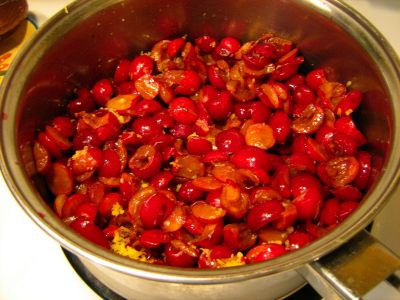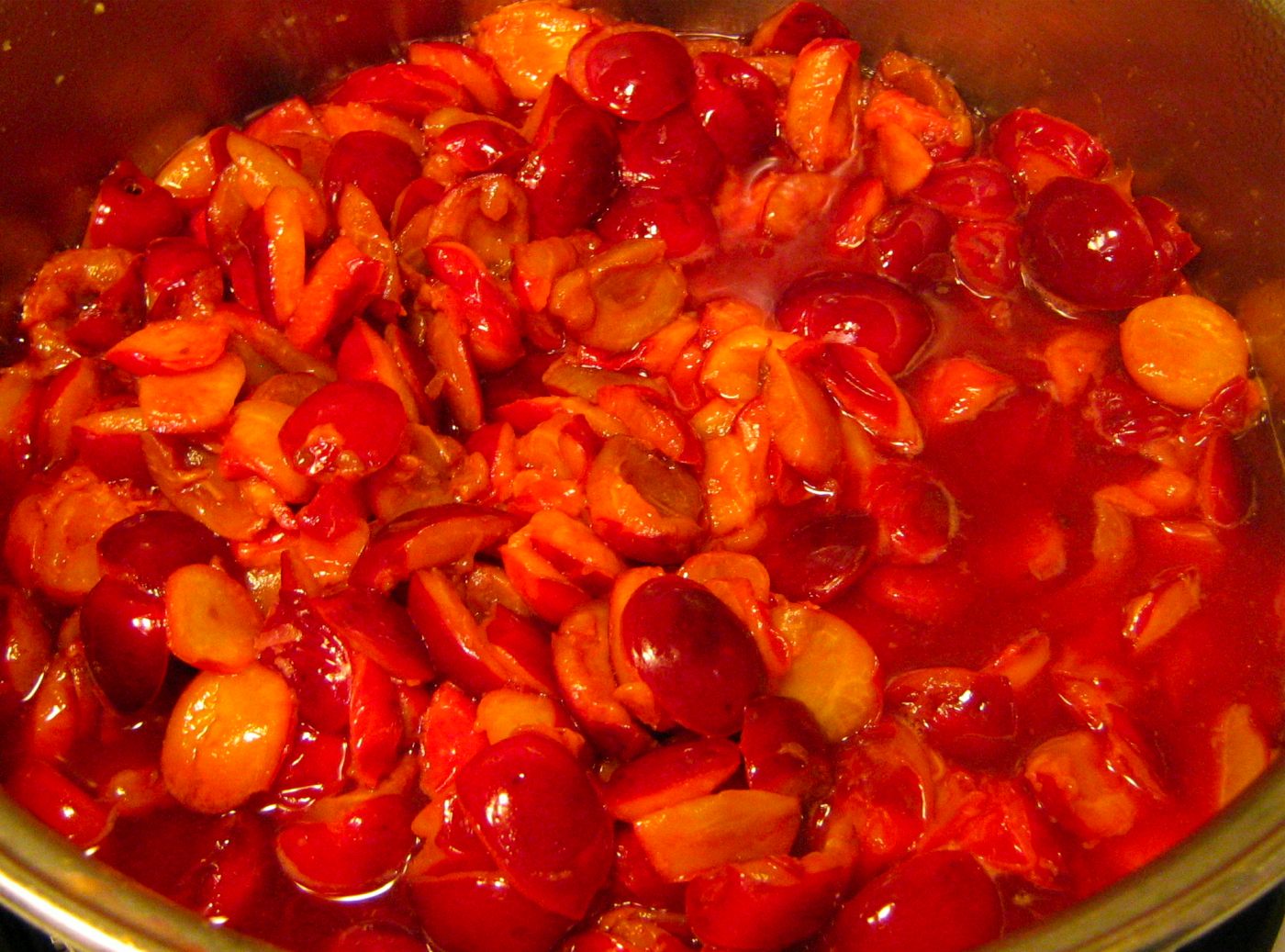When making jam, do not:
1. Run out of sugar after you’ve pitted 6 pints of valuable organic sour cherries
2. Think powdered sugar is a suitable replace for that last cup of granulated sugar that you don’t have
3. Forget that powdered sugar has cornstarch in it
4. Cry when you realize that your jam is basically a rock after spending hours making jars and jars (well, 4…but lots of work) of the stuff
I didn’t cry, but I did yell and swear a little. I know you have to bake the cornstarch out of powdered sugar, but I was flustered, a bit panicked and very tired when I realized I was a cup short of sugar and I was past the sour cherry jam-making breaking point. There’s a point after hich there’s no going back. I’m not 2 minutes from a grocery store and I’d just spent a good few hours pitting these lovely things that have a very short growing season and really didn’t want to leave my kitchen where my jars were boiling madly, being sterilized on my stove.
And jams can be dangerous if you don’t add enough sugar. I now know it would have been fine without that last cup but at the time I didn’t want to take the chance of wrecking the entire batch. Irony, right?
It wasn’t ruined. I did everything else right – waited until the jam was the right consistency (which may not have been correct, actually, because the cornstarch would make the jam thicker without necessarily reaching the correct temperature, though I’m sure it’s fine because of how hard the jam came out in the end), properly sterilized everything, used my new, fancy jar lifters to not rotate the jars when placing them back in the boiling water canner, etc.
Here’s the recipe in case you still have sour cherries somehow (not the dark red ones – the lighter red ones that have a mix of red and orange to their skins, and do taste sweet and sour, rather than just sweet), and feel like pitting them, buying enough sugar, not freaking out and adding powdered sugar, and enjoying properly-made jam. I made a few with vanilla amaretto by adding it to the cherries after I’d already filled most of the jars, and then letting it boil for another few minutes to cook off a tiny bit of the booze. You can skip that step completely, or add rum or rum extract or your sweet liqueur of choice.
Organic Sour Cherry Jam with Vanilla Amaretto
The recipe is from David Lebovitz’s blog (the comments in parentheses are mine), and it’s called “No-Recipe Cherry Jam”. I would normally never NOT use a recipe for jam, since quantities in preserves are so important, but it’s David Lebovitz, and really it is a recipe anyway. Just a loose one. It would more aptly be named “Adaptable and Relatively Easy Cherry Jam”
1. Buy as many cherries as you feel like pitting. One pound of cherries will make one standard 250mL jar of jam.
2. Wear something red (I didn’t believe this instruction because while pitting my cherries they didn’t splatter anywhere and I thought I was lucky, but once you get these guys on the heat they start spluttering up a storm, so take heed). Rinse the cherries and remove the stems. Pit the cherries and chop about 3/4ths of them into smaller pieces, but not too small. Leave some cherries whole so people can see later on how hard you worked pitting real cherries. If you leave too many whole ones, they’ll tumble off your toast (and cook more slowly, which is frustrating since you’ll be standing over the pot, stirring longer and getting covered in red).
3. Cook the cherries in a large non-reactive stockpot. It should be pretty big since the juices bubble up. Add the zest and juice of one or two fresh lemons. Lemon juice adds pectin as well as acidity, and will help the jam gel later on.
4. Cook the cherries, stirring once in a while with a heatproof spatula, until they’re wilted and completely soft, which may take about 20 minutes, depending on how much heat you give them. Aren’t they beautiful, all juicy and red? (Yes, David, they are lovely, but I very much wish they’d hurry up and break down).
5. Once they’re cooked, measure out how many cherries you have (including the juice.) Use 3/4 of the amount of sugar. For example if you have 4 cups of cooked cherry matter, add 3 cups of sugar. It may seem like a lot, but that amount of sugar is necessary to keep the jam from spoilage (this is why I got scared, but I’d actually measured my cherries before hand by weight to avoid the post-booking mess, which is NOT what you’re supposed to do, and I probably should have used less sugar anyway).
6. Stir the sugar and the cherries in the pot and cook over moderate-to-high heat. (Add 2 tbsp vanilla amaretto or your liqueur of choice now if you want the alcohol to cook off, or add it below when David says to do so to keep it alcoholic). The best jam is cooked quickly. While it’s cooking, put a small white plate in the freezer. Remain vigilant (and covered in red) and stir the fruit often with a heatproof utensil. Wouldn’t it be a shame to burn it at this point? (Yes, David, but there are greater evils, such as cornstarch and powdered sugar…) Scrape the bottom of the pot as you stir as well.
7. Once the bubbles subside and the jam appears a bit thick and looks like it is beginning to gel, (it will coat the spatula in a clear, thick-ish, jelly-like layer, but not too thick) turn off the heat and put a small amount of jam on the frozen plate and return to the freezer. After a few minutes, when you nudge it if it wrinkles, it’s done.
If not, cook it some more, turn off the heat, and test it again. If you overcook your jam, the sugar will caramelize and it won’t taste good and there’s nothing you can do (Yeah, oops. Over-cooked and cornstarch-y). Better to undercook it, test it, then cook it some more.
Once it’s done and gelled, add a bit of kirsch if you have it, clear cherry eau-de-vie which will highlight the flavor. Or add a few drops of almond extract, but not too much, or it will taste like a cheap Italian cake (the same goes for adding too much amaretto). Ladle the warm jam into clean, sterilized jars and cover (or follow proper canning procedures to make shelf-stable – boil 10 minutes in a hot water canner). Cool at room temperature, then put in the refrigerator where it will keep for several months.
See, you did it! (Almost, David. Almost.)


Leave a Reply